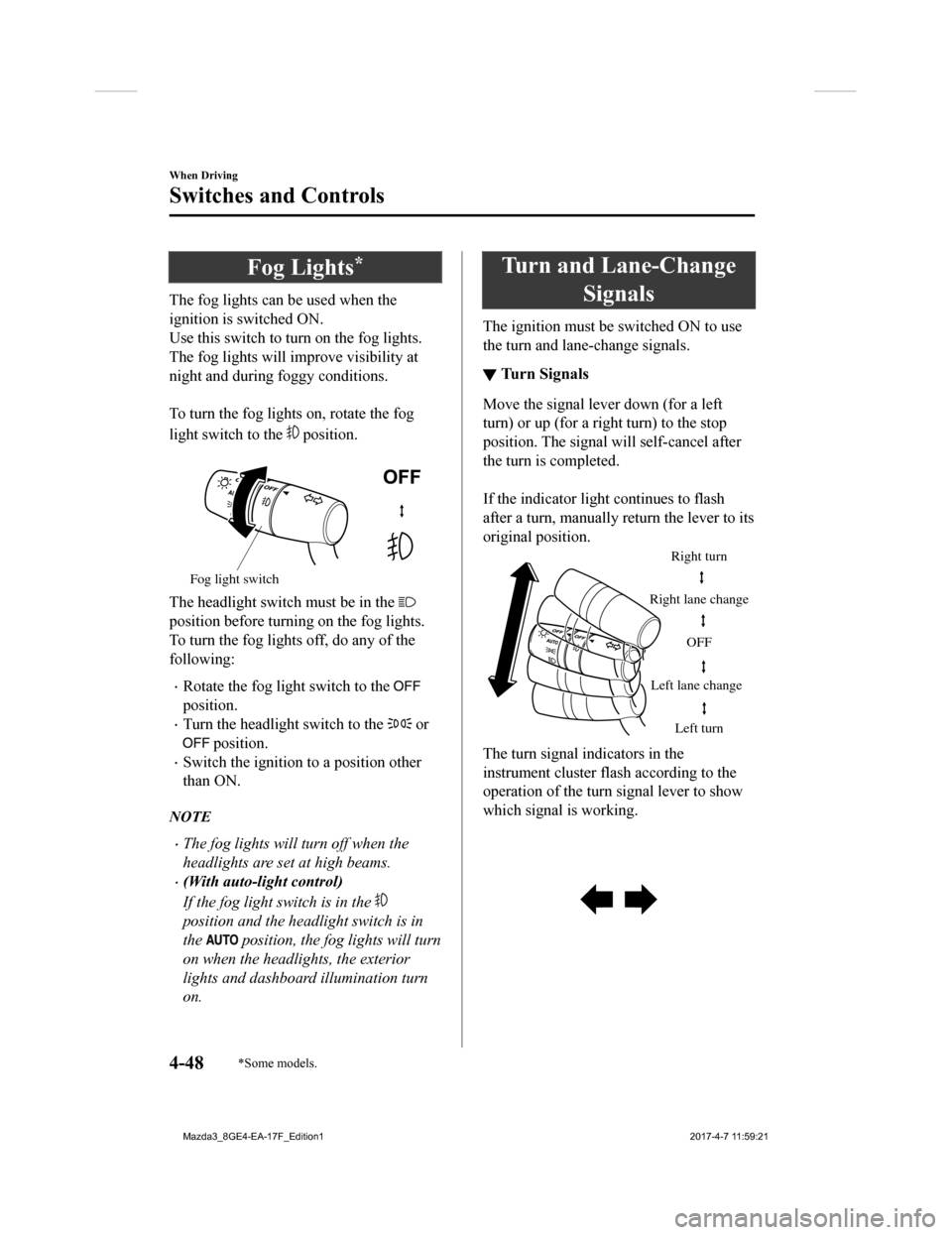2018 MAZDA MODEL 3 HATCHBACK fog lights
[x] Cancel search: fog lightsPage 133 of 624

4When Driving
Information concerning safe driving and stopping.
Start/Stop Engine.............................. 4-4 Ignition Switch........ ..................... 4-4
Starting the Engine....................... 4-5
Turning the Engine Off...............4-10
Instrument Cluster and Display............
........................................................... 4-12 Meters and Gauges..................... 4-12
Active Driving Display
*............. 4-20
Warning/Indicator Lights............4-23
Manual Transaxle Operation......... 4-29 Manual Transaxle Shift
Pattern......................................... 4-29
Automatic Transaxle....................... 4-32 Automatic Transaxle
Controls...................................... 4-32
Shift-Lock System...................... 4-33
Transaxle Ranges........................4-33
Manual Shift Mode..................... 4-35
Direct Mode
*.............................. 4-41
Driving Tips................................4-42
Switches and Controls..................... 4-43
Lighting Control......................... 4-43
Fog Lights
*................................. 4-48
Turn and Lane-Change
Signals........................................ 4-48
Windshield Wipers and
Washer........................................ 4-49
Rear Window Wiper and Washer
*.....
.................................................... 4-53
Rear Window Defogg er.............. 4-53
Horn............................................ 4-55
Hazard Warning Flasher............. 4-56
HomeLink Wireless Control
System
*.......................................4-56
Brake................................................ 4-60 Brake System.............................. 4-60
Hill Launch Assist (HLA).......... 4-64
ABS/TCS/DSC................................. 4-66 Antilock Brake System
(ABS)..........................................4-66
Traction Control System
(TCS).......................................... 4-67
Dynamic Stability Control
(DSC)..........................................4-68
i-ELOOP.......................................... 4-70 i-ELOOP
*................................... 4-70
Fuel Economy Monitor................... 4-72 Fuel Economy Monitor
*............. 4-72
*Some models.4-1
Mazda3_8GE4-EA-17F_Edition1 2017-4-7 11:59:21
Page 180 of 624

Fog Lights*
The fog lights can be used when the
ignition is switched ON.
Use this switch to turn on the fog lights.
The fog lights will improve visibility at
night and during foggy conditions.
To turn the fog light s on, rotate the fog
light switch to the
position.
Fog light switch
The headlight switch must be in the
position before turning on the fog lights.
To turn the fog lights off, do any of the
following:
Rotate the fog light switch to the
position.
Turn the headlight switch to the or
position.
Switch the ignition t o a position other
than ON.
NOTE
The fog lights will turn off when the
headlights are set at high beams.
(With auto-lig ht control)
If the fog light switch is in the
position and the headlight switch is in
the
position, the fog lights will turn
on when the headlights, the exterior
lights and dashboard illumination turn
on.
Turn and Lane-Change Signals
The ignition must be switched ON to use
the turn and lane-change signals.
▼Tu r n S i g n a l s
Move the signal lever down (for a left
turn) or up (for a right turn) to the stop
position. The signal will self-cancel after
the turn is completed.
If the indicator light continues to flash
after a turn, ma
nually return th e lever to its
original position.
Right turn
Left turn
Right lane change
Left lane change OFF
The turn signal indicators in the
instrument cluster
flash according to the
operation of the turn signal lever to show
which signal is working.
When Driving
Switches and Controls
4-48*Some models.
Mazda3_8GE4-EA-17F_Edition1 2017-4-7 11:59:21
Page 214 of 624

NOTE
The timing in which the system switches the headlights changes under the following
conditions. If the system does not switch the headlights appropriately, manually switch
between high and low beams according to the visibility as well as road and traffic
conditions.
When there are sources of light in the area such as street lamps, illuminated signboards,
and traffic signals.
When there are reflective objects in the surrounding area such as reflective plates and
signs.
When visibility is reduced under rain, snow and foggy conditions.
When driving on roads with sharp turn or hilly terrain.
When the headlights/rear lamps of vehicles in front of you or in the opposite lane are dim
or not illuminated.
When there is sufficient darkness such as at dawn or dusk.
When the luggage compartment is loaded with heavy objects or the rear passenger seats
are occupied.
When visibility is reduced due to a vehicle in front of you spraying water from its tires
onto your windshield.
▼ To Operate the System
The HBC operates to sw
itch the headlights
automatically between high and low
beams after the ignition is switched ON
and the headlight switch is in the AUTO
and high beam position.
The HBC determines t hat it is dark based
on the brightness of the surrounding area.
At the same time, th e HBC indicator light
(green) in the instrument cluster
illuminates.
The HBC determines t hat it is dark based
on the brightness of the surrounding area.
NOTE
When the vehicle speed is about 30 km/h
(19 mph) or more, the headlights
automatically switch to high beams
when there are no vehicles ahead or
approaching in the opposite direction.
When the vehicle speed is less than
about 20 km/h (12 mph), the HBC
switches the headlights to low beams.
The low beams may not switch to high
beams when cornering.
Operation of the HBC function can be
disabled. Refer to Personalization
Features on page 9-12.
When Driving
i-ACTIVSENSE
4-82
Mazda3_8GE4-EA-17F_Edition1 2017-4-7 11:59:21
Page 218 of 624

In the following case, the flashing of the BSM warning indicator light, and the activation
of the warning sound and the warning screen indicator display may not occur or they may
be delayed.
A vehicle makes a lane change from a driving lane two lanes over to an adjacent lane.
Driving on steep slopes.
Crossing the summit of a hill or mountain pass.
When there is a difference in the height between your driving lane and the adjacent
lane.
Directly after the BSM system becomes operable by changing the setting.
If the road width is extremely narrow, vehicles two lanes over may be detected. The
detection area of the radar sensors (rear) is set according to the road width of
expressways.
The BSM warning indicator light may turn on and the vehicle detection screen may be
displayed in the display in reaction to stationary objects (guardrails, tunnels, sidewalls,
and parked vehicles) on the road or the roadside.
The walls at the entrance and exits of tunnels,
turnouts.
Objects such as guardrails and concrete walls
running alongside the vehicle. Places where the width between guardrails or
walls on each side of the vehicle narrows.
A BSM warning indicator ligh
t may flash or the warning beep and the warning screen
indicator display may be activated several times when making a turn at a city
intersection.
Turn off the BSM while pulling a trailer or while an accessory such as a bicycle carrier is
installed to the rear of the vehicle. Otherwis e, the radar’s radio waves will be blocked
causing the system to not operate normally.
In the following cases, it may be difficult to view the illumination/flashing of the BSM
warning indicator lights equipped on the door mirrors.
Snow or ice is adhering to the door mirrors.
The front door glass is fogged or covered in snow, frost or dirt.
When Driving
i-ACTIVSENSE
4-86
Mazda3_8GE4-EA-17F_Edition1 2017-4-7 11:59:21
Page 220 of 624

Forward driving (BSM operation)
The BSM detects vehicles approaching from the rear and turns on the BSM warning
indicator lights equipped on the door mirrors according to the conditions. Additionally,
while a BSM warning i ndicator light is illuminated, if the turn signal lever is operated to
signal a turn in the direction in which the BSM warning indicat or light is illuminated, the
BSM warning indicator light flashes.
Reverse driving (Rear Cross Traf fic Alert (RCTA) system operation)
The Rear Cross Traffic Alert (RCTA) system detects vehicles app roaching from the left and
right of your vehicle and flashes the BSM warning indicator lig hts.
Function for cancelling illumination dimmer
If the BSM warning indicator lights turn on when the parking li ghts are turned on, the
brightness of the BSM warning indicator lights is dimmed.
If the BSM warning indicator lights are difficult to see due to glare from surrounding
brightness when traveling on snow-covered roads or under foggy conditions, press the
dimmer cancellation button to can cel the dimmer and increase the brightness of BSM
warning indicator lights when they turn on.
Refer to Dashboard Illumination on page 4-16.
Display indicator (Vehicles with active driving display)
The detected approaching vehicle and warning are displayed in t he active driving display
when the vehicle is moving forward (BSM operational).
The detected direction is displayed with a detection indicator (white) when an approaching
vehicle is detected. In addition , if the turn signal lever is o perated to signal a lane change
while the vehicle is detected, the display changes the color (a mber) of the warning indicator.
BSM warning beep
The BSM warning beep is activated simultaneously with the flash ing of a BSM warning
indicator light.
When Driving
i-ACTIVSENSE
4-88
Mazda3_8GE4-EA-17F_Edition1 2017-4-7 11:59:21
Page 223 of 624

Stop sign
WA R N I N G
Always check the traffic signs visually while driving.
The TSR helps prevent the driver from overlooking traffic signs and provides support for safer
driving. Depending on the weather conditions or problems with traffic signs, a traffic sign may
not be recognized or a traffic sign different from the actual traffic sign may be displayed.
Always make it your responsibility as a driver to check the actual traffic signs. Otherwise, it
could result in an accident.
NOTE
The TSR does not operate if there is a malf unction in the Forward Sensing Camera (FSC).
Under the following conditions, the TSR may not operate normally.
An object placed on the dashboard is reflected in the windshield and picked up by the
camera.
Heavy luggage is loaded in the luggage compartment or on the rear seat and the
vehicle is tilted.
The tire pressures are not adjusted to the specified pressure.
Tires other than standard tires are equipped.
The vehicle is driven on the ramp and surrounding area to or from a rest area or a
tollgate on a highway.
When surrounding brightness suddenly changes such as when entering or exiting a
tunnel.
The illumination of the headlights is weakened because of dirt or the optical axis is
deviated.
The windshield is dirty or foggy.
When Driving
i-ACTIVSENSE
4-91
Mazda3_8GE4-EA-17F_Edition1 2017-4-7 11:59:21
Page 224 of 624

The windshield and camera are fogged (water droplets).
Strong light is directed at the front of the vehicle (such as backlight or high-beam
headlights of on-coming vehicles).
The vehicle is making a sharp turn.
Strong light reflects off the road.
A traffic sign is in a position which makes it difficult to reflect the light from the
vehicle's headlights, such as when the vehicle is driven at night or in a tunnel.
The vehicle is driven under weather conditions such as rain, fog, or snow.
The stored map data for the navigation system is not current.
A traffic sign is obscured by mud or snow.
A traffic sign is concealed by trees or a vehicle.
A traffic sign is partially shaded.
A traffic sign is bent or warped.
A traffic sign is too low or too high.
A traffic sign is too bright or too da rk (including electronic traffic signs).
A traffic sign is too big or too small.
There is an object similar to the traffic sign being read (such as another traffic sign or
other signs resembling it).
The TSR does not operate if the active dr iving display is set to non-display.
The TSR can be set to inoperable.
Refer to Personalization Features on page 9-12.
▼Traffic Sign Display Indication
The following traffic signs are d
isplayed on the active driving display.
Speed limit signs
Do not enter signs
When Driving
i-ACTIVSENSE
4-92
Mazda3_8GE4-EA-17F_Edition1 2017-4-7 11:59:21
Page 233 of 624

In the following cases, it may be difficult to view the illumination/flashing of the Blind
Spot Monitoring (BSM) warning indicator lights equipped on the door mirrors.
Snow or ice adheres to the door mirrors.
The front door glass is fogged or covered in snow, frost or dirt.
Turn off the RCTA system while pulling a trailer or while an accessory such as a bicycle
carrier is installed to the rear of the vehic le. Otherwise, the radio waves emitted by the
radar will be blocked causing the system to not operate normally.
When Driving
i-ACTIVSENSE
4-101
Mazda3_8GE4-EA-17F_Edition1 2017-4-7 11:59:21